SOC 30019: Representations of Gender in Media - A Magazine Analysis
VerifiedAdded on 2023/03/31
|6
|1627
|256
Report
AI Summary
This report presents a content analysis of gender representation in magazine advertisements, focusing on whether ads use dominant ideals of femininity and masculinity to sell products. The study uses a coding method to categorize qualitative data from "Prevention Magazine," assessing the intensity of male and female representation based on activities, roles, apparel, appearance, and demeanor. The results indicate that while both masculinity and femininity are used, stereotypical presentations persist, particularly in ads targeting specific genders. The report discusses these findings in the context of globalization, urbanization, and traditional cultural values, referencing theories like Goffman's "commercial realism" to understand how advertisements reflect and distort reality. The study concludes that despite societal pressures, stereotypical representations remain intact, raising questions about the media's role in challenging traditional norms. Desklib offers similar solved assignments and past papers for students.
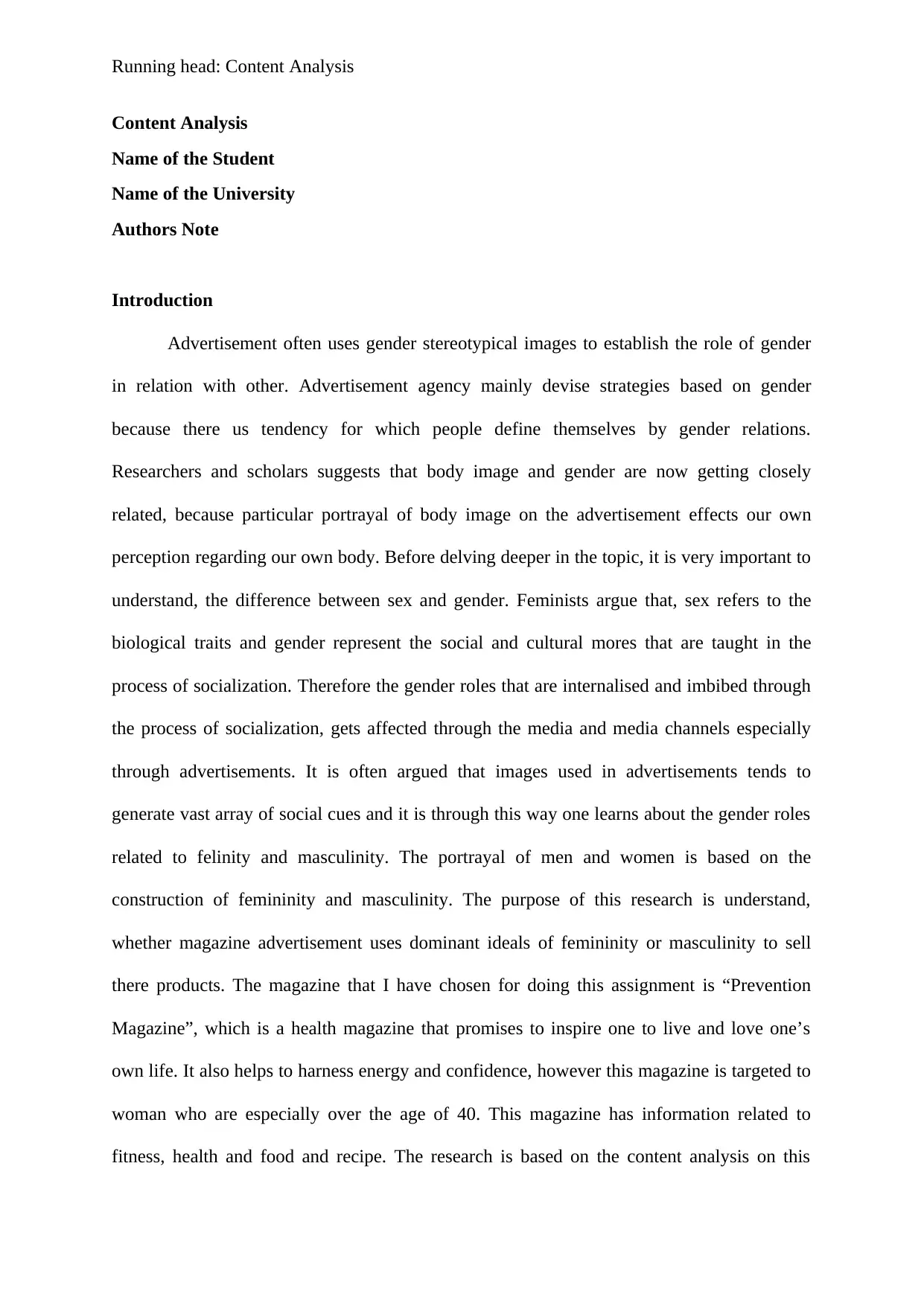
Running head: Content Analysis
Content Analysis
Name of the Student
Name of the University
Authors Note
Introduction
Advertisement often uses gender stereotypical images to establish the role of gender
in relation with other. Advertisement agency mainly devise strategies based on gender
because there us tendency for which people define themselves by gender relations.
Researchers and scholars suggests that body image and gender are now getting closely
related, because particular portrayal of body image on the advertisement effects our own
perception regarding our own body. Before delving deeper in the topic, it is very important to
understand, the difference between sex and gender. Feminists argue that, sex refers to the
biological traits and gender represent the social and cultural mores that are taught in the
process of socialization. Therefore the gender roles that are internalised and imbibed through
the process of socialization, gets affected through the media and media channels especially
through advertisements. It is often argued that images used in advertisements tends to
generate vast array of social cues and it is through this way one learns about the gender roles
related to felinity and masculinity. The portrayal of men and women is based on the
construction of femininity and masculinity. The purpose of this research is understand,
whether magazine advertisement uses dominant ideals of femininity or masculinity to sell
there products. The magazine that I have chosen for doing this assignment is “Prevention
Magazine”, which is a health magazine that promises to inspire one to live and love one’s
own life. It also helps to harness energy and confidence, however this magazine is targeted to
woman who are especially over the age of 40. This magazine has information related to
fitness, health and food and recipe. The research is based on the content analysis on this
Content Analysis
Name of the Student
Name of the University
Authors Note
Introduction
Advertisement often uses gender stereotypical images to establish the role of gender
in relation with other. Advertisement agency mainly devise strategies based on gender
because there us tendency for which people define themselves by gender relations.
Researchers and scholars suggests that body image and gender are now getting closely
related, because particular portrayal of body image on the advertisement effects our own
perception regarding our own body. Before delving deeper in the topic, it is very important to
understand, the difference between sex and gender. Feminists argue that, sex refers to the
biological traits and gender represent the social and cultural mores that are taught in the
process of socialization. Therefore the gender roles that are internalised and imbibed through
the process of socialization, gets affected through the media and media channels especially
through advertisements. It is often argued that images used in advertisements tends to
generate vast array of social cues and it is through this way one learns about the gender roles
related to felinity and masculinity. The portrayal of men and women is based on the
construction of femininity and masculinity. The purpose of this research is understand,
whether magazine advertisement uses dominant ideals of femininity or masculinity to sell
there products. The magazine that I have chosen for doing this assignment is “Prevention
Magazine”, which is a health magazine that promises to inspire one to live and love one’s
own life. It also helps to harness energy and confidence, however this magazine is targeted to
woman who are especially over the age of 40. This magazine has information related to
fitness, health and food and recipe. The research is based on the content analysis on this
Paraphrase This Document
Need a fresh take? Get an instant paraphrase of this document with our AI Paraphraser
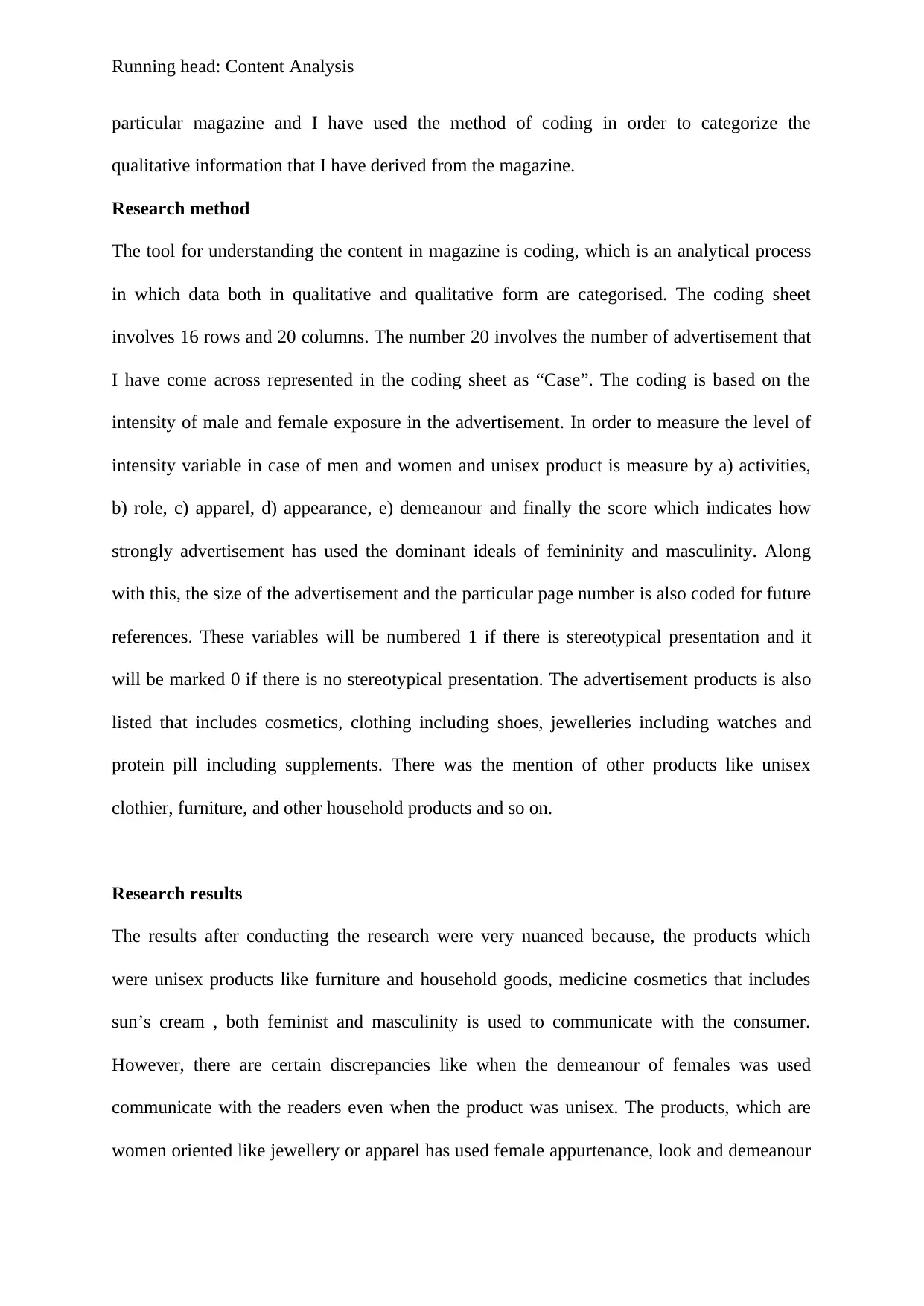
Running head: Content Analysis
particular magazine and I have used the method of coding in order to categorize the
qualitative information that I have derived from the magazine.
Research method
The tool for understanding the content in magazine is coding, which is an analytical process
in which data both in qualitative and qualitative form are categorised. The coding sheet
involves 16 rows and 20 columns. The number 20 involves the number of advertisement that
I have come across represented in the coding sheet as “Case”. The coding is based on the
intensity of male and female exposure in the advertisement. In order to measure the level of
intensity variable in case of men and women and unisex product is measure by a) activities,
b) role, c) apparel, d) appearance, e) demeanour and finally the score which indicates how
strongly advertisement has used the dominant ideals of femininity and masculinity. Along
with this, the size of the advertisement and the particular page number is also coded for future
references. These variables will be numbered 1 if there is stereotypical presentation and it
will be marked 0 if there is no stereotypical presentation. The advertisement products is also
listed that includes cosmetics, clothing including shoes, jewelleries including watches and
protein pill including supplements. There was the mention of other products like unisex
clothier, furniture, and other household products and so on.
Research results
The results after conducting the research were very nuanced because, the products which
were unisex products like furniture and household goods, medicine cosmetics that includes
sun’s cream , both feminist and masculinity is used to communicate with the consumer.
However, there are certain discrepancies like when the demeanour of females was used
communicate with the readers even when the product was unisex. The products, which are
women oriented like jewellery or apparel has used female appurtenance, look and demeanour
particular magazine and I have used the method of coding in order to categorize the
qualitative information that I have derived from the magazine.
Research method
The tool for understanding the content in magazine is coding, which is an analytical process
in which data both in qualitative and qualitative form are categorised. The coding sheet
involves 16 rows and 20 columns. The number 20 involves the number of advertisement that
I have come across represented in the coding sheet as “Case”. The coding is based on the
intensity of male and female exposure in the advertisement. In order to measure the level of
intensity variable in case of men and women and unisex product is measure by a) activities,
b) role, c) apparel, d) appearance, e) demeanour and finally the score which indicates how
strongly advertisement has used the dominant ideals of femininity and masculinity. Along
with this, the size of the advertisement and the particular page number is also coded for future
references. These variables will be numbered 1 if there is stereotypical presentation and it
will be marked 0 if there is no stereotypical presentation. The advertisement products is also
listed that includes cosmetics, clothing including shoes, jewelleries including watches and
protein pill including supplements. There was the mention of other products like unisex
clothier, furniture, and other household products and so on.
Research results
The results after conducting the research were very nuanced because, the products which
were unisex products like furniture and household goods, medicine cosmetics that includes
sun’s cream , both feminist and masculinity is used to communicate with the consumer.
However, there are certain discrepancies like when the demeanour of females was used
communicate with the readers even when the product was unisex. The products, which are
women oriented like jewellery or apparel has used female appurtenance, look and demeanour
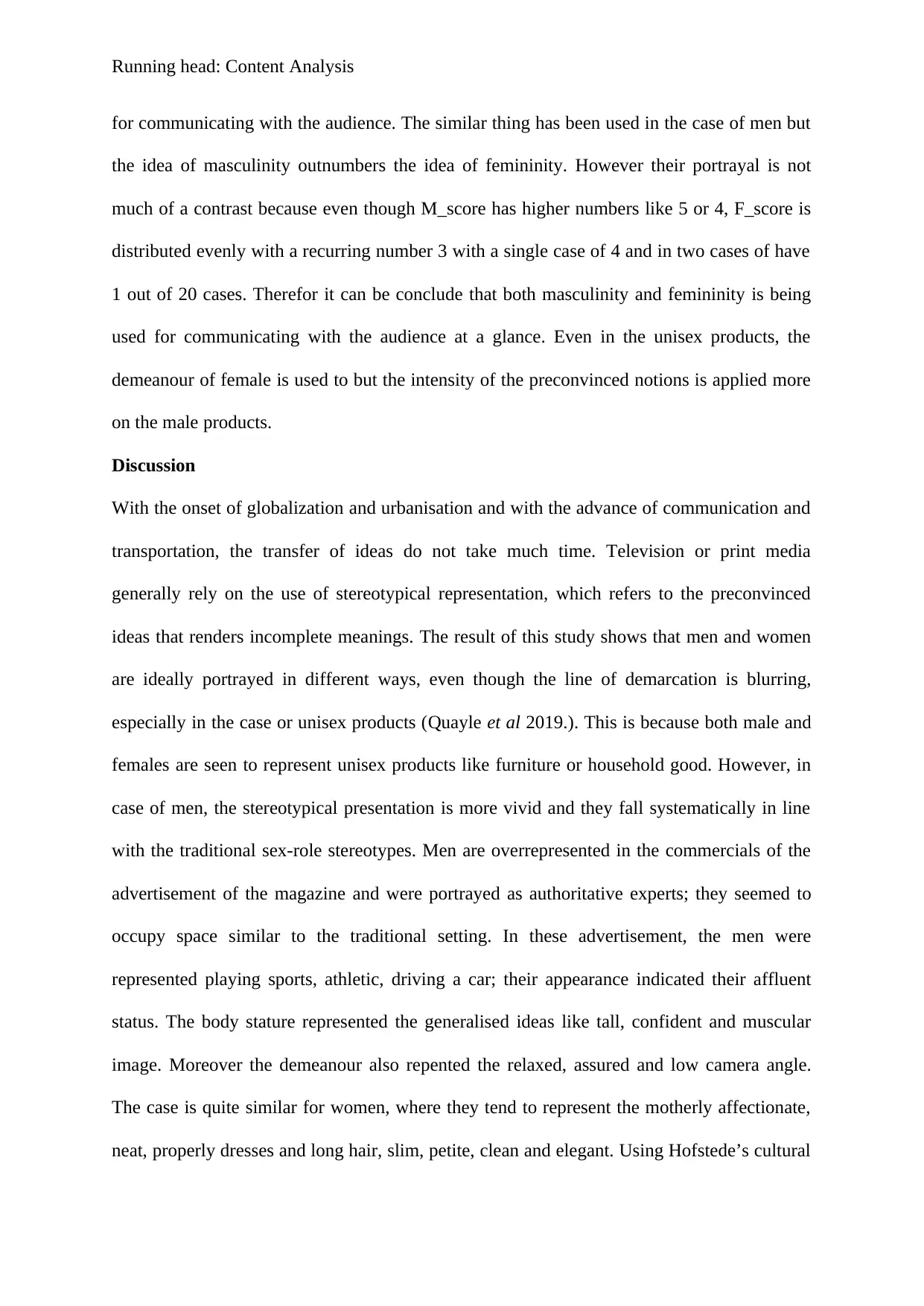
Running head: Content Analysis
for communicating with the audience. The similar thing has been used in the case of men but
the idea of masculinity outnumbers the idea of femininity. However their portrayal is not
much of a contrast because even though M_score has higher numbers like 5 or 4, F_score is
distributed evenly with a recurring number 3 with a single case of 4 and in two cases of have
1 out of 20 cases. Therefor it can be conclude that both masculinity and femininity is being
used for communicating with the audience at a glance. Even in the unisex products, the
demeanour of female is used to but the intensity of the preconvinced notions is applied more
on the male products.
Discussion
With the onset of globalization and urbanisation and with the advance of communication and
transportation, the transfer of ideas do not take much time. Television or print media
generally rely on the use of stereotypical representation, which refers to the preconvinced
ideas that renders incomplete meanings. The result of this study shows that men and women
are ideally portrayed in different ways, even though the line of demarcation is blurring,
especially in the case or unisex products (Quayle et al 2019.). This is because both male and
females are seen to represent unisex products like furniture or household good. However, in
case of men, the stereotypical presentation is more vivid and they fall systematically in line
with the traditional sex-role stereotypes. Men are overrepresented in the commercials of the
advertisement of the magazine and were portrayed as authoritative experts; they seemed to
occupy space similar to the traditional setting. In these advertisement, the men were
represented playing sports, athletic, driving a car; their appearance indicated their affluent
status. The body stature represented the generalised ideas like tall, confident and muscular
image. Moreover the demeanour also repented the relaxed, assured and low camera angle.
The case is quite similar for women, where they tend to represent the motherly affectionate,
neat, properly dresses and long hair, slim, petite, clean and elegant. Using Hofstede’s cultural
for communicating with the audience. The similar thing has been used in the case of men but
the idea of masculinity outnumbers the idea of femininity. However their portrayal is not
much of a contrast because even though M_score has higher numbers like 5 or 4, F_score is
distributed evenly with a recurring number 3 with a single case of 4 and in two cases of have
1 out of 20 cases. Therefor it can be conclude that both masculinity and femininity is being
used for communicating with the audience at a glance. Even in the unisex products, the
demeanour of female is used to but the intensity of the preconvinced notions is applied more
on the male products.
Discussion
With the onset of globalization and urbanisation and with the advance of communication and
transportation, the transfer of ideas do not take much time. Television or print media
generally rely on the use of stereotypical representation, which refers to the preconvinced
ideas that renders incomplete meanings. The result of this study shows that men and women
are ideally portrayed in different ways, even though the line of demarcation is blurring,
especially in the case or unisex products (Quayle et al 2019.). This is because both male and
females are seen to represent unisex products like furniture or household good. However, in
case of men, the stereotypical presentation is more vivid and they fall systematically in line
with the traditional sex-role stereotypes. Men are overrepresented in the commercials of the
advertisement of the magazine and were portrayed as authoritative experts; they seemed to
occupy space similar to the traditional setting. In these advertisement, the men were
represented playing sports, athletic, driving a car; their appearance indicated their affluent
status. The body stature represented the generalised ideas like tall, confident and muscular
image. Moreover the demeanour also repented the relaxed, assured and low camera angle.
The case is quite similar for women, where they tend to represent the motherly affectionate,
neat, properly dresses and long hair, slim, petite, clean and elegant. Using Hofstede’s cultural
⊘ This is a preview!⊘
Do you want full access?
Subscribe today to unlock all pages.

Trusted by 1+ million students worldwide
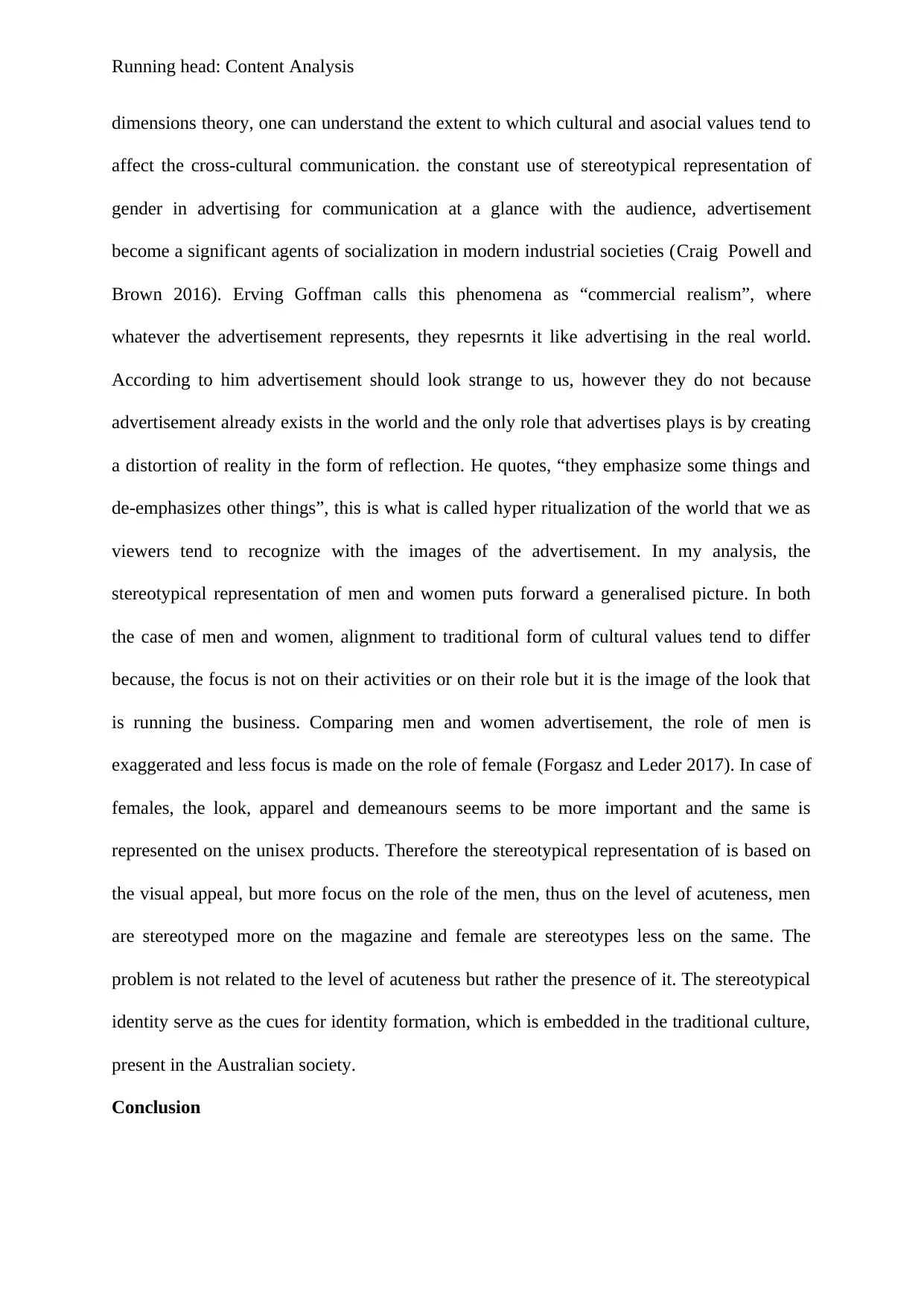
Running head: Content Analysis
dimensions theory, one can understand the extent to which cultural and asocial values tend to
affect the cross-cultural communication. the constant use of stereotypical representation of
gender in advertising for communication at a glance with the audience, advertisement
become a significant agents of socialization in modern industrial societies (Craig Powell and
Brown 2016). Erving Goffman calls this phenomena as “commercial realism”, where
whatever the advertisement represents, they repesrnts it like advertising in the real world.
According to him advertisement should look strange to us, however they do not because
advertisement already exists in the world and the only role that advertises plays is by creating
a distortion of reality in the form of reflection. He quotes, “they emphasize some things and
de-emphasizes other things”, this is what is called hyper ritualization of the world that we as
viewers tend to recognize with the images of the advertisement. In my analysis, the
stereotypical representation of men and women puts forward a generalised picture. In both
the case of men and women, alignment to traditional form of cultural values tend to differ
because, the focus is not on their activities or on their role but it is the image of the look that
is running the business. Comparing men and women advertisement, the role of men is
exaggerated and less focus is made on the role of female (Forgasz and Leder 2017). In case of
females, the look, apparel and demeanours seems to be more important and the same is
represented on the unisex products. Therefore the stereotypical representation of is based on
the visual appeal, but more focus on the role of the men, thus on the level of acuteness, men
are stereotyped more on the magazine and female are stereotypes less on the same. The
problem is not related to the level of acuteness but rather the presence of it. The stereotypical
identity serve as the cues for identity formation, which is embedded in the traditional culture,
present in the Australian society.
Conclusion
dimensions theory, one can understand the extent to which cultural and asocial values tend to
affect the cross-cultural communication. the constant use of stereotypical representation of
gender in advertising for communication at a glance with the audience, advertisement
become a significant agents of socialization in modern industrial societies (Craig Powell and
Brown 2016). Erving Goffman calls this phenomena as “commercial realism”, where
whatever the advertisement represents, they repesrnts it like advertising in the real world.
According to him advertisement should look strange to us, however they do not because
advertisement already exists in the world and the only role that advertises plays is by creating
a distortion of reality in the form of reflection. He quotes, “they emphasize some things and
de-emphasizes other things”, this is what is called hyper ritualization of the world that we as
viewers tend to recognize with the images of the advertisement. In my analysis, the
stereotypical representation of men and women puts forward a generalised picture. In both
the case of men and women, alignment to traditional form of cultural values tend to differ
because, the focus is not on their activities or on their role but it is the image of the look that
is running the business. Comparing men and women advertisement, the role of men is
exaggerated and less focus is made on the role of female (Forgasz and Leder 2017). In case of
females, the look, apparel and demeanours seems to be more important and the same is
represented on the unisex products. Therefore the stereotypical representation of is based on
the visual appeal, but more focus on the role of the men, thus on the level of acuteness, men
are stereotyped more on the magazine and female are stereotypes less on the same. The
problem is not related to the level of acuteness but rather the presence of it. The stereotypical
identity serve as the cues for identity formation, which is embedded in the traditional culture,
present in the Australian society.
Conclusion
Paraphrase This Document
Need a fresh take? Get an instant paraphrase of this document with our AI Paraphraser
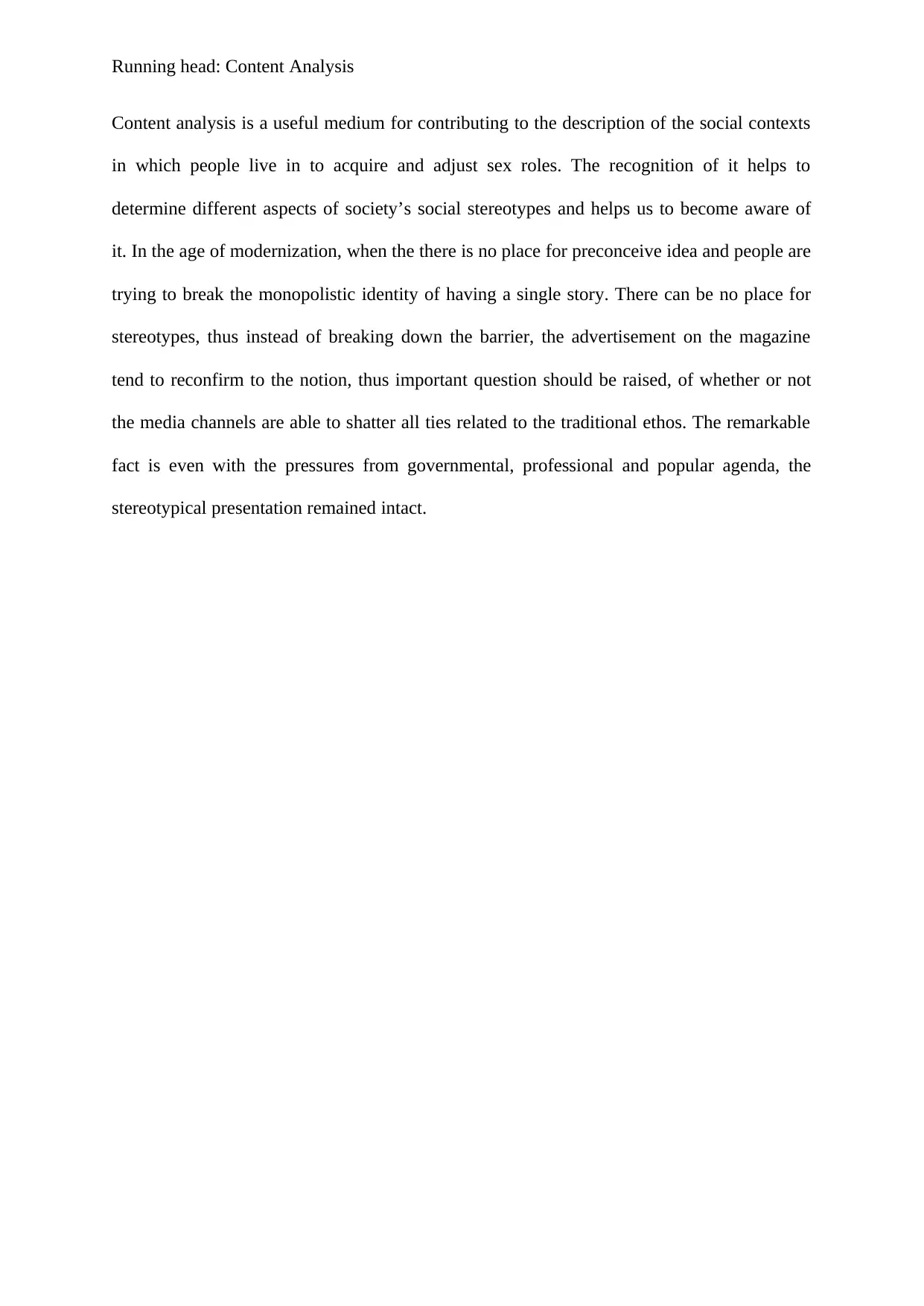
Running head: Content Analysis
Content analysis is a useful medium for contributing to the description of the social contexts
in which people live in to acquire and adjust sex roles. The recognition of it helps to
determine different aspects of society’s social stereotypes and helps us to become aware of
it. In the age of modernization, when the there is no place for preconceive idea and people are
trying to break the monopolistic identity of having a single story. There can be no place for
stereotypes, thus instead of breaking down the barrier, the advertisement on the magazine
tend to reconfirm to the notion, thus important question should be raised, of whether or not
the media channels are able to shatter all ties related to the traditional ethos. The remarkable
fact is even with the pressures from governmental, professional and popular agenda, the
stereotypical presentation remained intact.
Content analysis is a useful medium for contributing to the description of the social contexts
in which people live in to acquire and adjust sex roles. The recognition of it helps to
determine different aspects of society’s social stereotypes and helps us to become aware of
it. In the age of modernization, when the there is no place for preconceive idea and people are
trying to break the monopolistic identity of having a single story. There can be no place for
stereotypes, thus instead of breaking down the barrier, the advertisement on the magazine
tend to reconfirm to the notion, thus important question should be raised, of whether or not
the media channels are able to shatter all ties related to the traditional ethos. The remarkable
fact is even with the pressures from governmental, professional and popular agenda, the
stereotypical presentation remained intact.
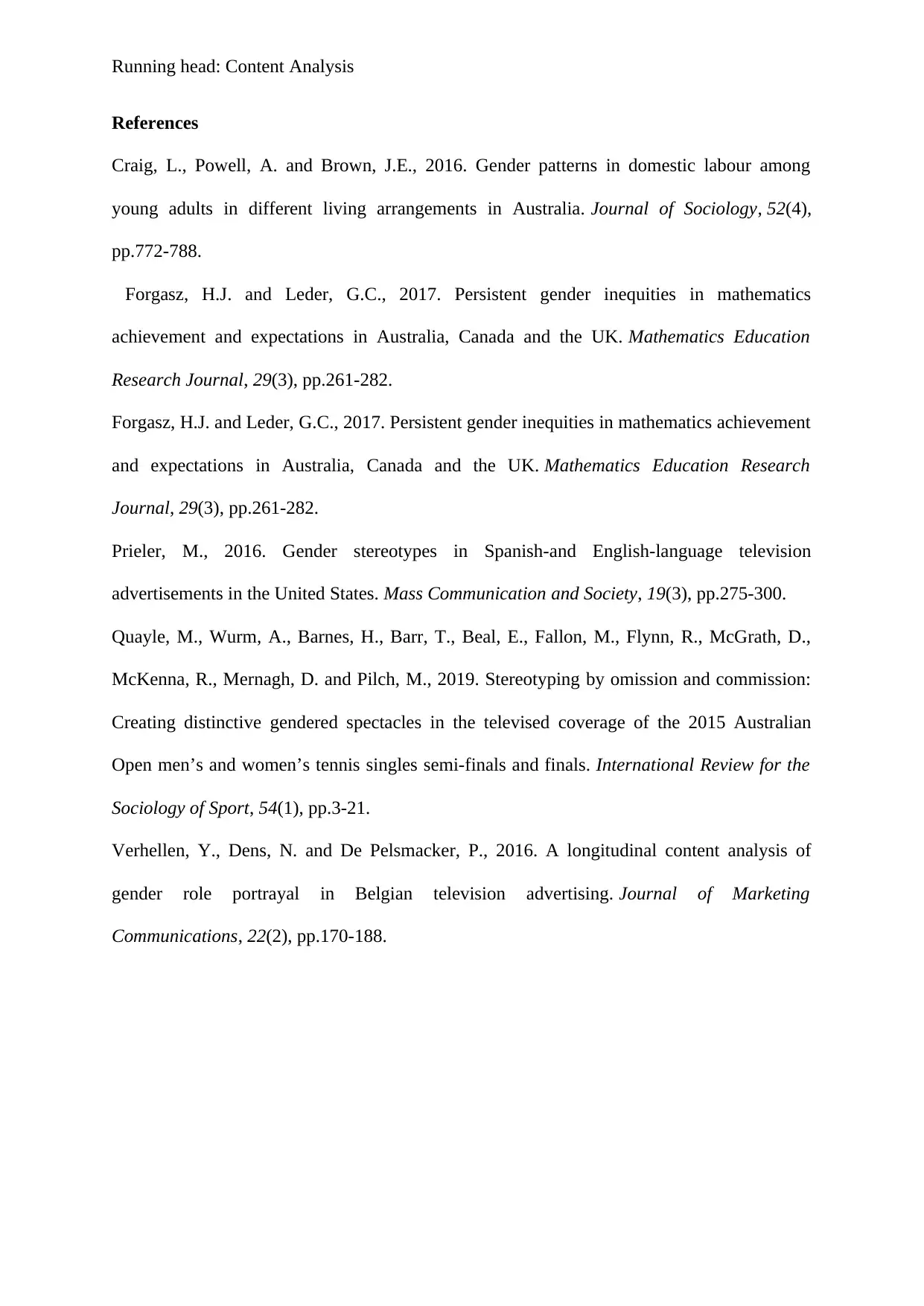
Running head: Content Analysis
References
Craig, L., Powell, A. and Brown, J.E., 2016. Gender patterns in domestic labour among
young adults in different living arrangements in Australia. Journal of Sociology, 52(4),
pp.772-788.
Forgasz, H.J. and Leder, G.C., 2017. Persistent gender inequities in mathematics
achievement and expectations in Australia, Canada and the UK. Mathematics Education
Research Journal, 29(3), pp.261-282.
Forgasz, H.J. and Leder, G.C., 2017. Persistent gender inequities in mathematics achievement
and expectations in Australia, Canada and the UK. Mathematics Education Research
Journal, 29(3), pp.261-282.
Prieler, M., 2016. Gender stereotypes in Spanish-and English-language television
advertisements in the United States. Mass Communication and Society, 19(3), pp.275-300.
Quayle, M., Wurm, A., Barnes, H., Barr, T., Beal, E., Fallon, M., Flynn, R., McGrath, D.,
McKenna, R., Mernagh, D. and Pilch, M., 2019. Stereotyping by omission and commission:
Creating distinctive gendered spectacles in the televised coverage of the 2015 Australian
Open men’s and women’s tennis singles semi-finals and finals. International Review for the
Sociology of Sport, 54(1), pp.3-21.
Verhellen, Y., Dens, N. and De Pelsmacker, P., 2016. A longitudinal content analysis of
gender role portrayal in Belgian television advertising. Journal of Marketing
Communications, 22(2), pp.170-188.
References
Craig, L., Powell, A. and Brown, J.E., 2016. Gender patterns in domestic labour among
young adults in different living arrangements in Australia. Journal of Sociology, 52(4),
pp.772-788.
Forgasz, H.J. and Leder, G.C., 2017. Persistent gender inequities in mathematics
achievement and expectations in Australia, Canada and the UK. Mathematics Education
Research Journal, 29(3), pp.261-282.
Forgasz, H.J. and Leder, G.C., 2017. Persistent gender inequities in mathematics achievement
and expectations in Australia, Canada and the UK. Mathematics Education Research
Journal, 29(3), pp.261-282.
Prieler, M., 2016. Gender stereotypes in Spanish-and English-language television
advertisements in the United States. Mass Communication and Society, 19(3), pp.275-300.
Quayle, M., Wurm, A., Barnes, H., Barr, T., Beal, E., Fallon, M., Flynn, R., McGrath, D.,
McKenna, R., Mernagh, D. and Pilch, M., 2019. Stereotyping by omission and commission:
Creating distinctive gendered spectacles in the televised coverage of the 2015 Australian
Open men’s and women’s tennis singles semi-finals and finals. International Review for the
Sociology of Sport, 54(1), pp.3-21.
Verhellen, Y., Dens, N. and De Pelsmacker, P., 2016. A longitudinal content analysis of
gender role portrayal in Belgian television advertising. Journal of Marketing
Communications, 22(2), pp.170-188.
⊘ This is a preview!⊘
Do you want full access?
Subscribe today to unlock all pages.

Trusted by 1+ million students worldwide
1 out of 6
Related Documents
Your All-in-One AI-Powered Toolkit for Academic Success.
+13062052269
info@desklib.com
Available 24*7 on WhatsApp / Email
![[object Object]](/_next/static/media/star-bottom.7253800d.svg)
Unlock your academic potential
Copyright © 2020–2025 A2Z Services. All Rights Reserved. Developed and managed by ZUCOL.





